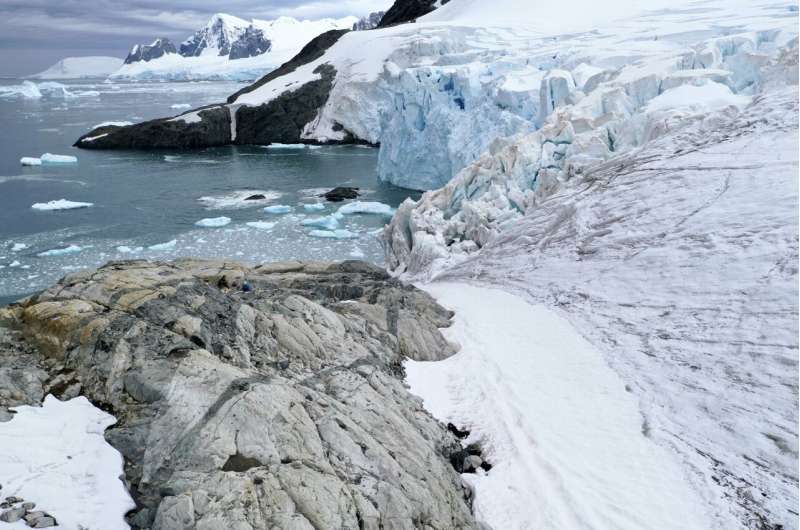
In their new paper for the Geological Society of America journal GeologyDulcinea Groff and colleagues used radiocarbon ages (kill dates) of previously ice-entombed dead black mosses to reveal that glaciers advanced during three distinct phases in the northern Antarctic Peninsula over the past 1,500 years.
The terrestrial cryosphere and biosphere of the Antarctic Peninsula are changing rapidly as “first responders” to polar warming. We know from other studies that large glaciers of the Antarctic Peninsula are responding quickly to warmer summer air temperatures, and scientists have modeled that the glaciers expanded in the past because of cooler temperaturesand not increased precipitation. However, we know much less about how this plays out at sea level where ice, ocean, and sensitive coastal life interact. Knowing when glaciers advanced and retreated in the past would improve our understanding of biodiverse coastal ecosystems—thriving with seals, penguins, and plants—and their sensitivity in the Antarctic Peninsula. One of the limitations of reconstructing glacier history is that there are not that many types of terrestrial archives we can use to constrain past glacier behavior. Re-exposed dead plants, abandoned penguin colonies, and rocks can be dated to better know the timing of permanent snow or glacier advance in the past.
Mosses are one of the few types of plants living in Antarctica and can get overridden and killed by advancing glaciers. The timing of when the glacier killed the moss provides an archive of glacier history. For example, when glaciers expand or advance, they can entomb or cover the plant—starving it of light and warmth. The date the plant died is the same time the glacier advanced over that location. As glaciers recede, these previously entombed mosses are exposed and are dead and black. “What’s so valuable about these kill dates compared to other records (like the ages of glacial erratics or penguin remains) is their accuracy,” says Groff. They provide a clearer picture of the climate history owing to their direct carbon exchange with the atmosphere and decreased error around the age estimate.
Groff and colleagues collected black mosses around the northern Antarctic Peninsula by exploring the edges of glaciers and nunataks at several locations. By radiocarbon dating the mosses, they found that glaciers advanced three times in the past 1,500 years. This is evidence for phases of cooler and potentially wetter conditions than today. On Anvers Island, they learned that the last time the glacier was at its 2019 position was around 850 years ago as it expanded over the course of several centuries. Their estimates of glacier advance are much slower than recent retreat. “Interestingly, we found that the glacier front with the fastest advance also had the fastest retreat, suggesting that hotspots of rapid coastal glacier dynamics occur in the Antarctic Peninsula, says Groff.

This is a unique dataset because it’s rare to have past net advance rates in the literature because glacial records tend to be destroyed when the glacier advances. These black mosses can reliably be used to estimate glacier advances in the past. “There are other lines of evidence that support our moss kill dates for past cooler conditions, such as peat records indicating lower biological productivity, as well as evidence for sea-level change from raised beaches as a result of changing ice mass. It’s also possible that the climate conditions that led to glacier advances involved wetter conditions and would have had a negative impact on penguins, as we know they do today. Many of the recent abandoned penguin colonies are the same age as our youngest black moss,” says Groff.
More information:Dulcinea V. Groff et al, Kill dates from re-exposed black mosses constrain past glacier advances in the northern Antarctic Peninsula, Geology (2023). DOI: 10.1130/G50314.1
Citation:Kill dates for re-exposed black mosses (2023, January 26)retrieved 3 February 2023from https://phys.org/news/2023-01-dates-re-exposed-black-mosses.html
This document is subject to copyright. Apart from any fair dealing for the purpose of private study or research, no part may be reproduced without the written permission. The content is provided for information purposes only.
Note: This article have been indexed to our site. We do not claim legitimacy, ownership or copyright of any of the content above. To see the article at original source Click Here













